|
 |
The Commodore PET
(Model : CBM 8096) |
Options
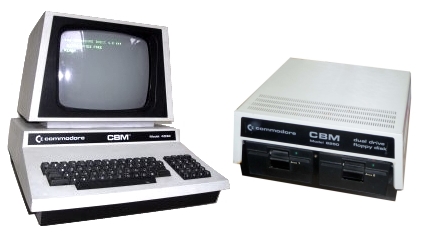
As might be expected for a computer with such a large range
of models, there were also a large range of options available,
including Commodore's own disk drives and printers, as well as
third party add-ons. I shall only be documenting the options
that I have, or am very interested in obtaining - however
unlikely that may be.
|
Disk Drives |
Commodore produced
a large range of floppy disk options which used a number
of different formats. This page only describes the 8250
model, which features 2 x
full
height, 5.25, Double Sided / Quad Density drives.
Although the disk drives were Quad Density, they were
not Dual Density, and could not, for example, read the
lower density
Commodore 1541 disk format used on the
Commodore 64. |
|
Model 8250 |
| Disk Drives |
2 x 5.25" DS/QD 300
RPM |
| Tracks |
77 / side |
| Tracks / inch (tpi) |
100 |
| Sectors/Track |
23-29 (2083 / side) |
| Bytes/Sector |
256 |
| Capacity |
1.04MB (520KB / side) |
| Coding |
Group Code Recording (GCR) |
| Access time |
5ms |
| Track/Track seek |
125ms |
| Interface |
IEEE-488 |
| Firmware |
16kB ROM with DOS 2.7 |
| Disk buffer |
4kB RAM |
| Dimensions (h x w x d) |
180mm x 380mm x 395mm |
| Weight |
12.6 kg |
|
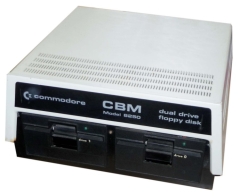 |
| The disk drives interface with the PET
using the
IEEE-488
interface. Photo from the Commodore Series 2000 User
Guide, showing the rear of a disk drive case and two
IEEE-488 cables - a standard "piggy-back" cable and the
PET edge connector to IEEE cable. |
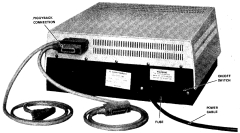 |
| The piggy-back cable is a standard 1m
IEEE-488 cable, these are quite common. The PET edge
connector cable was a "special" designed by Commodore
for the PET IEEE interface. |
 |
| The Commodore cable is hard to find
these days, but I bought an adapter for use with a
standard IEEE-488 cable (bought for £5.50 from ebay)
from
RETRO Innovations in the US for $10 + shipping. |
  |
| The disk controller is installed under the
cover and a single interface board for the two disks is
installed on the right hand drive. Commodore built
their own drive products, the 8050 and 8250 used 100 TPI
drives manufactured by
Tandon,
MPI and
Micropolis (2 models). Commodore removed the OEM's
electronics and replaced them with their own.
As you can see in the photo, the 34 way ribbon cable
usually seen on floppy disk drive interfaces is not
present - after modification by Commodore, these drives
were no longer
Shugart compatible.
Credits :
Picture from Dave Dunfield's
Classic Computer
site's
PET pages
Technical data reference
Herb Johnson |
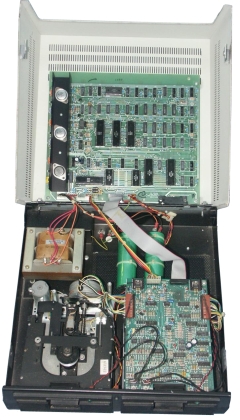 |
| A close up of the disk controller board,
which includes 2 x 6502 processors (1MHz), 16K ROM, 4K
RAM - the drive controller is computer in its own right
and included the Disk Operating System (DOS Version 2.7) on the
board.
Credits :
Picture downloaded from
Commodore Computer Online Museum |
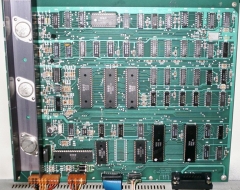 |
| A close up of the disk controller board,
with the major components identified from the
Dual Drive Service
Manual Data was transferred from the 8250 to the
PET over the IEEE-488 bus at 1.8 KB/s. (The later
VIC-20 and
Commodore 64 used a serial version of the IEEE bus
and only managed a throughput of 400 B/s) |
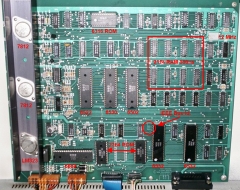 |
.
|
Madison Computer Z-RAM |
| Madison Computer developed
Z-RAM, a Z80 based add-on card that
enabled the PET to run CP/M. The 6502 was removed from
the PET main board, the Z-RAM card incorporated a
replacement 6502, a Z80A CPU clocked at 4MHz and
64KB of RAM. To the "new" 6502, the Z80 appeared as a
number of additional I/O ports.
It would be really great to have a Z-RAM for my 8096,
but the chance of finding one would seem to be
exceedingly slim.
Credits :
Details and image courtesy of
Mike Naberezny |
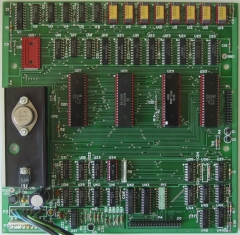 |
| |
|
| |
|
| |
|
|